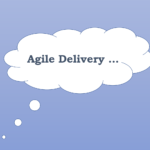A fixed price consultancy-led assessment of the effectiveness
of an Agile team with actions and strategies for improvement.
Target audience
The Agile Scrum Assessment is suitable for all teams
practising Agile methods that are now ready for independent validation.
The assessment process and follow-up session help teams that are falling behind expectations to understand what is going wrong, and provide a timely boost for established teams that are ready to progress to the next level of excellence.
Deliverables
- Executive summary
- Comprehensive report of your current state of Agile adoption
- On-site assessment of your team in action
- List of specific actions for immediate improvement
- Roadmap for increasing enterprise agility
- Checklist that can be used internally for future assessments
Benefits
- Shared platform for understanding and discussion with stakeholders
- We validate Agility in terms of the Agile Manifesto, irrespective of the methodology that has been adopted and evolved
- Identify potential risks and future threats that may impact performance
- Determine the team’s effectiveness in forecasting and delivering results
- Identify indicators of value and drivers for metrics
Unique value proposition
Most teams practice Agile as a hybrid of Scrum, Kanban or Lean, a bit of XP plus a healthy dose of whatever they are most familiar with. Whilst this may not be the ideal approach, and may cause challenges, it is the reality for most of our clients.
Storm don’t take the usual “religious” approach of assessing pure Scrum, XP, DSDM or SAFe rituals. We won’t award your team a silver instead of a gold star because someone said “daily stand-up” instead of “scrum”. Or tell you to stop calling your BAs “BAs”!
Storm’s is a completely neutral, independent and objective assessment. Since value is always relative to its context, there is no single metric that all organisations can pursue. We evaluate the effectiveness of your process according to what is valuable for you.
Service Delivery
Storm’s Agile Scrum Assessment comprises 5 distinct phases of activity:
- Agree objectives and brief the team
- Observe team activities
- Conduct one-on-one interviews
- Analyse data and present findings
- Formal retrospective of actionable improvements
The assessment is carried out on-site, and is led by a Principal Consultant, who is supported by 1-2 other Consultants depending on the size of the team.
1. Setting objectives
Experience shows that people are willing to participate fully and openly when they understand the purpose and reason for an activity.
If the point of the assessment is to confirm the current situation with a view to finding and making improvements, then that must be shared as the goal. If the purpose is to identify cost-savings which could include re-assigning roles, then that too should be disclosed. Transparency is a core tenet of Agile.
Objectives are agreed with the sponsors of the assessment. The team briefing follows and marks the start of the service delivery.
2. Observing team activities
Agile methods have clearly-defined ceremonies and artefacts that are designed to increase collaboration and value-production. Familiarity, resistance and over-confidence tend to dilute their effectiveness. Many times, meetings are “adapted” to suit the culture of the organisation, but unbeknown to its participants, this often compromises its effectiveness.
The way team members interact with each other at these meetings is the main determinant in the team’s overall effectiveness. Often there are issues which are well-known to everyone, and it takes an external voice to facilitate acceptance and recovery from these situations.
3. One on one interviews
Successful teamwork is intensely people-based and experience shows that providing your team members with the opportunity to discuss work issues in confidence, has significant and often immediate benefits.
Each interviews takes approximately 1-2 hours and can be conducted remotely for off-shore team members. The number of interviews conducted affects the price of this package.
4. Analysis and sponsor agreement
This stage of the process represents Storm’s “unique value proposition”.
Our Consultants synthesise the mass of data gleaned through observation and elicitation, filtering-out the “noise” and producing meaningful information. They further distil that information into focussed findings and valuable action points, which are presented to the sponsors of the assessment in the form of a written report which delivers the assessment over three key areas[1].
The content of this report is specially codified so that the assessment’s sponsors are able to monitor and assess future performance using the established and understood measures.
The sponsors agree the action points that are to be presented to the team.
Reports are strictly company and sponsor confidential.
5. Retrospective on actionable findings
Retrospective meetings tend to be amongst the first casualties when the Agile begins to fail. Symptoms are attendees saying they find them boring, pointless or uncomfortable. If this happens, process improvement has stopped and the “rot” has begun to set-in.
Precisely because this is such a key and challenging meeting, we facilitate a formal retrospective meeting as a way of presenting the findings of the assessment, and to show how the meeting can be run in context and by direct example.
Conclusion
Storm’s Agile Scrum Assessment provides answers
to these questions:
- How Agile is your team?
- How good are they at forecasting and delivering to forecast?
- How effective are your planning, review, and working practices?
- Which areas are worth improving?
- What potential problems are brewing for the future?
[1] Reporting areas are the intellectual property of Storm Consulting and may be available on request.


